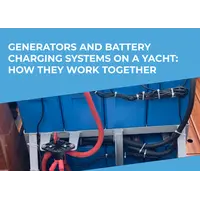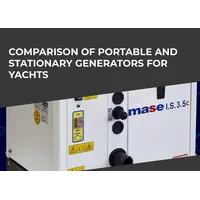topRik's experts explain what to consider when choosing an inflatable boat that you will use as a yacht tender. These tips are based on their many years of yachting experience using various types of boats.
Introduction
And the very first advice would be this: for any yacht - motor, sail, monohull or multihull - you should definitely buy an inflatable dinghy. This applies to both coastal boaters and ocean crossing enthusiasts. In both cases, you will need an ace for the following purposes:
- organization of entertainment activities on the water - diving, spearfishing, water skiing and mono-skiing, parasailing, etc.;
- mooring and unmooring, using a second anchor before spending the night on board;
- towing to turn the yacht in a narrow lagoon;
- refloating the yacht;
- inspection of the yacht's hull.
embarking and disembarking, as well as moving cargo to the pier and back – these are the main purposes of a dinghy;
problematic disembarking: when the shore is not equipped with berths or when the draft of the yacht does not allow usual procedures - an important function of the tender if you are fond of exploring unknown coasts, islets and shoals;
If you have decided on the tasks that the dinghy will perform on your yacht, think carefully about the regions in which you plan to sail. This is necessary not only in order to know the prevailing weather conditions, the presence and power of tidal waves and tidal currents, as wells as other climatic characteristics of the water area. In some regions, you will need to have a registration (license) for an engine of a certain power with a certain length of the dinghy.
In general, knowledge of the marine legislation of a particular country is very useful. If only to save money that you could otherwise spend on fines. For example, you will surely notice that the most popular for small inflatable dinghy are now outboard motors with a capacity of 9.8 and 9.9 HP. This is precisely due to the mandatory registration of engines with power from and above 10 HP. But also keep in mind that such an engine will not cope with towing a skier; for this, the engine power must be about 25 HP.
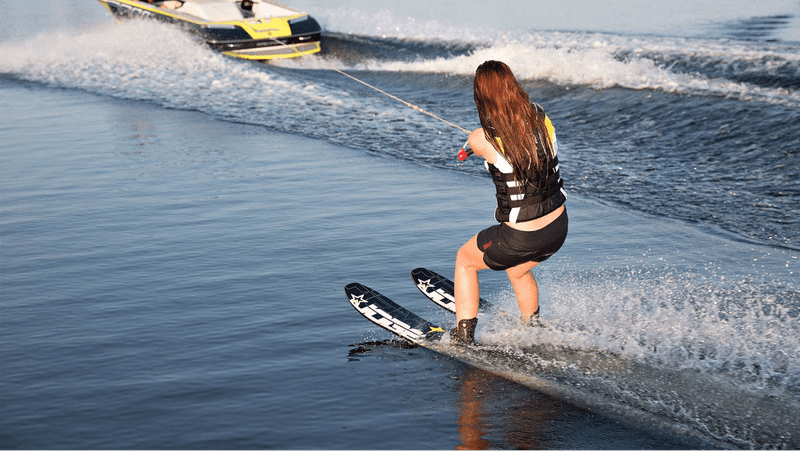
According to European regulations, inflatable boats up to three meters long can have a flat bottom . Longer boats should have a keeled bottom to improve handling and seaworthiness.
After you have decided on the tasks that your future inflatable tender will perform, its maximum load, in which region you will boat and what laws it will be guided by, you can easily determine the required dimensions (length, width), number of seats, carrying capacity, engine power, etc.
Going through all the above parameters, do not forget about another important specification: the free area on your yacht, where you can place the tender. And only when all this data is taken into account, you can begin to choose the type of your dinghy.
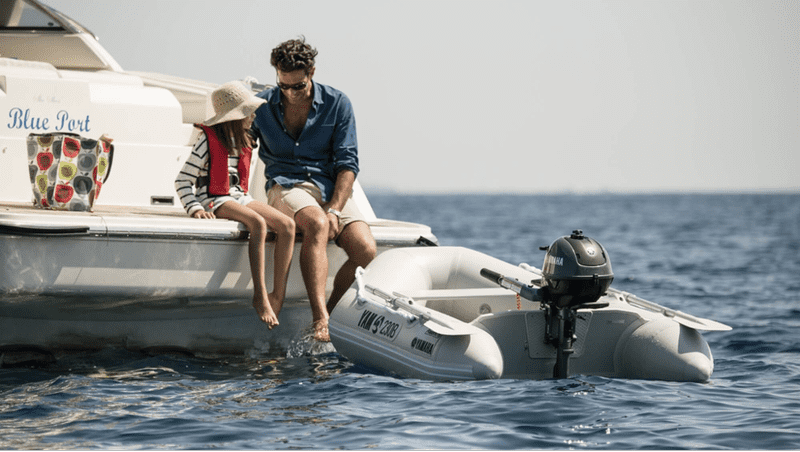
Types of Inflatable Boats
In this section, we consider only types of inflatable boats used with the engine, pure rowing designs are not suitable for our task. But since usually motor boats of a certain size are also equipped with oars, we can say that we are considering types of both motor and motor-rowing boats.
Motor-Rowing Boats
These are usually smaller and cheaper. Engine power largely depends not only on the size and carrying capacity of the boat, but also on the strength of the transom board, as well as its fastening.
There are the following types of motor-rowing boats:
- made from rubberized fabric;
- polyvinyl chloride (PVC);
- with a slatted floor made of different materials, including aluminum, to stiffen the bottom;
- with plywood or aluminum lining over the entire area of the bottom;
- with high- or low-pressure inflatable floor.
The cheapest are boats made of rubberized fabrics, but this cheapness is justified only when operating boats with low-power engines. Based on our experience, for a medium power motor (5-15 HP), it is better to choose a PVC boat - it will last longer.
Inflatable boats with medium power engines are optimized towards planing mode (lift allows the boat to move forward while touching the water surface only with the stern, while the bow of the boat is raised above the water). For planing, it is very important that the bottom of the boat is rigid.
This requirement leads to the fact that the use of semi-rigid rack sheets is found only on boats for low-power motors, and for medium-power motors, plywood or aluminum sheets and a high-pressure inflatable floor are used to stiffen the bottom.
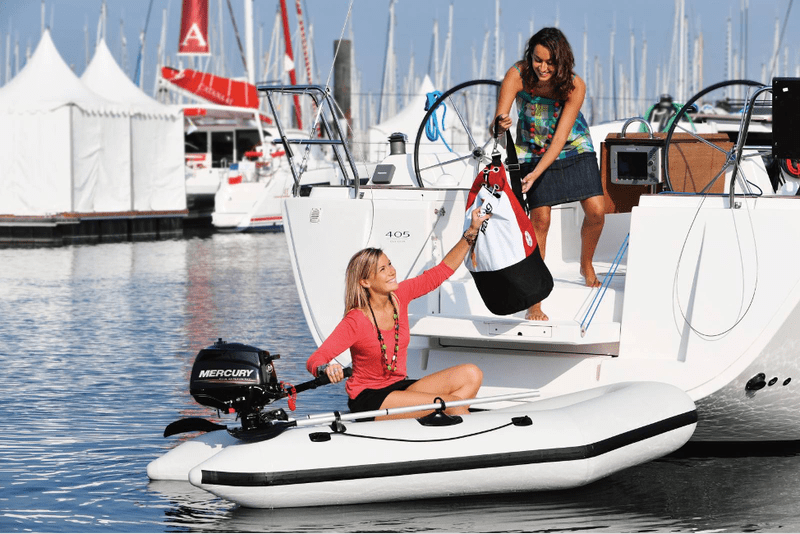
RIB – Rigid Inflatable Boat
This type of inflatable motorboat is great for yachts with a length of 20-50 meters. Usually, such yachts have a special garage for them, a large transom platform, davit beams or just enough free space on the foredeck or saloon roof to fit the RIB assembled or with the engine removed. The length of such boats starts from 3 meters.
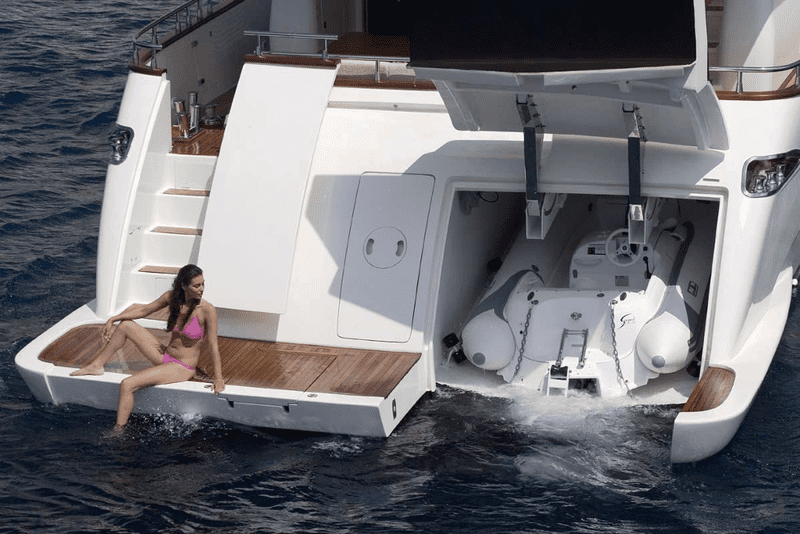
The body is usually made of plastic, and around its perimeter there are several large-diameter insulated inflatable chambers. The chamber material is PVC or hypalon (synthetic rubber).
A fairly powerful engine can be installed on a durable transom, depending on the size and carrying capacity of the boat.
Deck Tenders
These are boats that serve as tender boats on mega-yachts. As a rule, this is actually a small speedboat of the convertible type, with stationary engines, with a deck, wheelhouse or hardtop, so that rain and sea splashes don’t soak passengers and capacious luggage lockers. Depending on the size of the yacht, there may be more than one of these "convertibles" on board.
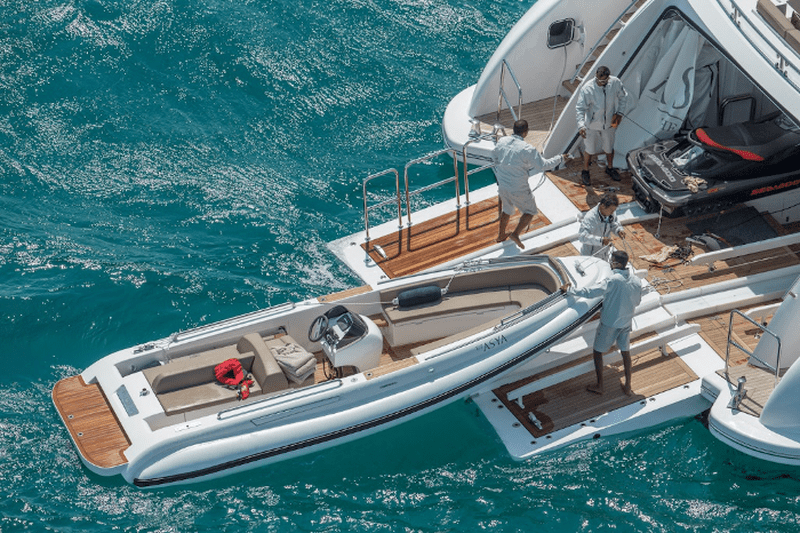
Advantages and Limitations of Each Type
The advantage of motor-rowing models is their ease of transportation - when folded, they fit into a large bag. The motor, seats and sheets are transported in the trunk. They take up little space on the yacht when folded, so they are good for yachts less than 20 meters long.
Thanks to their lightness, small models, inflated and fully assembled, can be transported on the roof of a large car or motorhome.
Isolated inflatable chambers (from 2 to 4) provide a greater opportunity to stay on the surface of the water if one of them is damaged.
One of the most critical components of a small motor-rowing inflatable boat is the rigid transom mount. Since the transom bears the main load, its connections to the hull most often fail. One of the most common reasons why a boat's transom comes off is the installation of motors with more power than allowed on the boat.
On Rigid Inflatable Boats can be equipped with powerful engines, both mounted and stationary. In this type of motor boats, the floats are isolated, but due to the increased diameter they are more reliable. These floats also act as a roll damper from a wave hitting the side.
In addition to the chambers, ribs also have a plastic body that stays afloat even with the chambers deflated - this is an additional buoyancy resource.
In the photo below you can see the bow of the yacht with Rigid Inflatable Boats located in two garages, custom built with inboard engines.
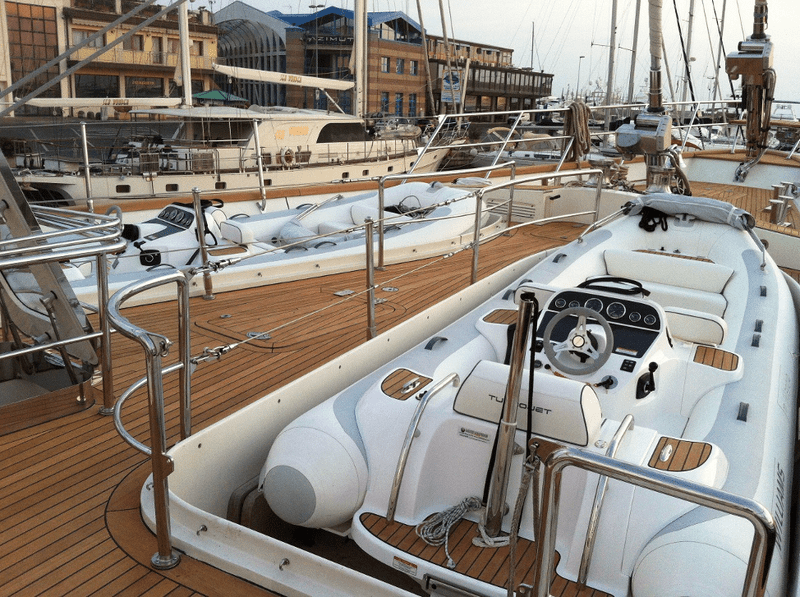
This type of boat, for all its superiority, also has a couple of limitations: the price and the mandatory use of trailer for transportation.
Materials and Design
If you want an inflatable boat to serve you for a long time, choose it taking into account the materials of used and design features.
Just think about how much issues you will have with a rubber boat in salt water under the hot tropical sun or in the cold waters of the Norwegian Sea. So usually, most of rubber tenders are only optimal for temperate latitudes and fresh water bodies.
After testing many products available on the market, we can say that for materials such as PVC, neopren and hypalon, neither temperature changes, nor ultraviolet radiation, nor exposure to salt are dangerous. Moreover, neopren surpasses polyvinyl chloride in all these indicators, but is inferior to hypalon. These two materials are elastomers, while PVC is a plastomer. So, pay attention to the number of PVC layers. There are cchambers made of five-layer PVC, the strength of which can compete with hypalon. But hypalon is clearly the leader in UV resistance, although it is significantly more expensive than PVC and neopren.
As for the hull of the RIB, it can be made of fiberglass, aluminum alloy or using carbon fiber - the name of the material is listed in order of increasing strength, reliability and wear resistance.
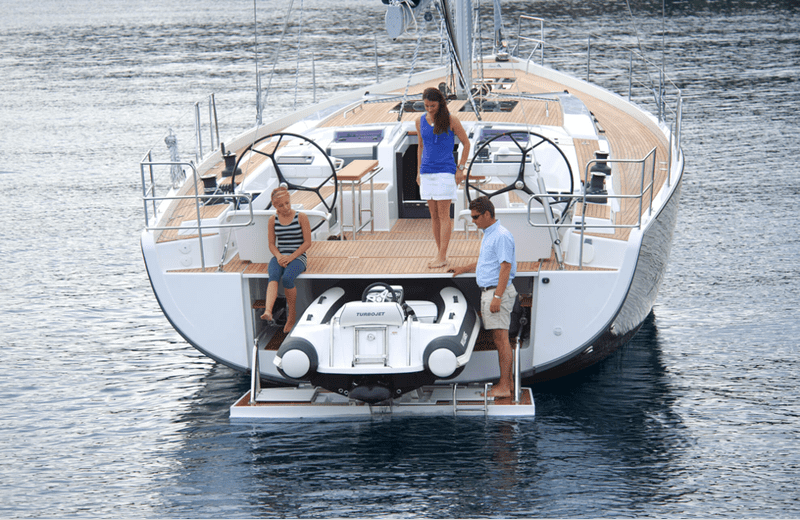
The durability and performance of the boat is also affected by its design. Tuzik can be designed as a displacement vessel or as a planing vessel. To enter the gliding requires a quick set of speed, that is, a powerful engine. It is clear that such a design wears out faster if the engine is selected incorrectly. But the same applies to a displacement vessel. The instructions usually indicate the engine power at which such a boat can reach maximum speed. You will not increase the performance of the dinghy if you put a more powerful motor, but you will accelerate its wear.
If the boat is equipped with a low-power engine, then this design is usually tiller-controlled. More powerful motors, such as those found on large RIBs or deck tenders, are equipped with remote control via a helm.
Another feature of the design of motor boats is the length of the deadwood, which is directly proportional to the size of the boat and, as a result, the height of the transom wall on which the engine is mounted.
Recently, the development of four-stroke outboard motors has been preferred. This is understandable: despite the fact that they are more expensive than two-stroke ones and have a lower power density, they are more economical, less noisy, with less vibration. For many, a higher environmental friendliness in comparison with two-stroke vehicles also speaks in their favor.
The advantages of the RIB design over conventional inflatable motor boats have been discussed above, as well as the fact that boats with a rigid or semi-rigid bottom or a high-pressure inflatable floor are superior in performance to conventional inflatable boats.
The durability of the boat, as well as its performance, also largely depends simply on sticking to the instructions for engine power and permissible load.
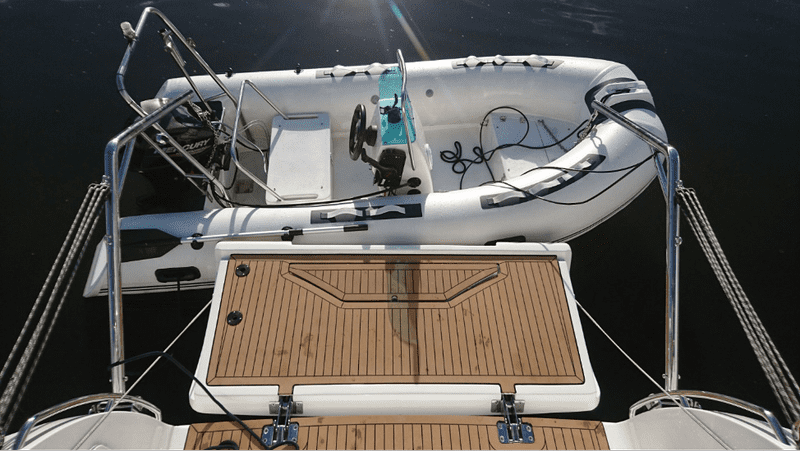
Size and Load Capacity
The size of your dinghy, as already mentioned, depends entirely on the area that you can allocate for it on your yacht. Just measure the garage, platform, part of the fore-deck or locker where you are going to store and transport the tender inflated or deflated.
In order for the dinghy to serve you for a long time, take the time to calculate in advance the load capacity you need. Consider the number of passengers who will use the tender, add to their weight the weight of the transported luggage, food, as well as the delivery of garbage to the disposal site. Don't forget folding bikes if you want to use them on land.
After that add another ten kilograms and one more seat - reinsurance in this matter will not be superfluous. Now you have an idea of what size, carrying capacity and passenger capacity your boat will be.
Storage and Transport Requirements
For storage and transportation of RIB or other types of inflatable dinghy, it is recommended to use a special awning, although this is an additional option for most manufacturers.
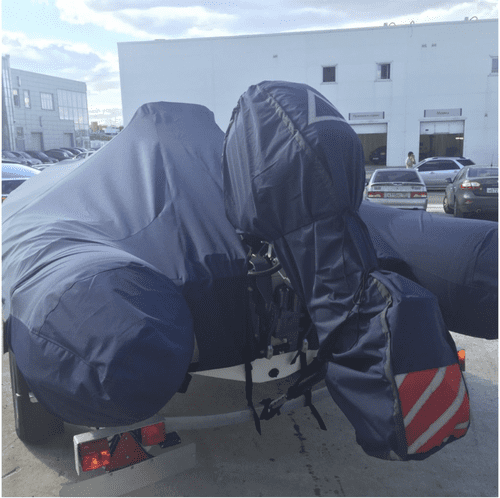
Ordinary motor boats can be transported in inflated form on the roof of a car or in a deflated state - in a special bag put in a trunk. If the bottom is equipped with slats or is reinforced with a sheet, these elements are pulled out in advance. The exceptions are separate designs with a folding bottom and a high or low pressure floor.
Transportation of RIB is carried out only by using a trailer. It is also possible to transport large inflatable boats with a soft bottom.
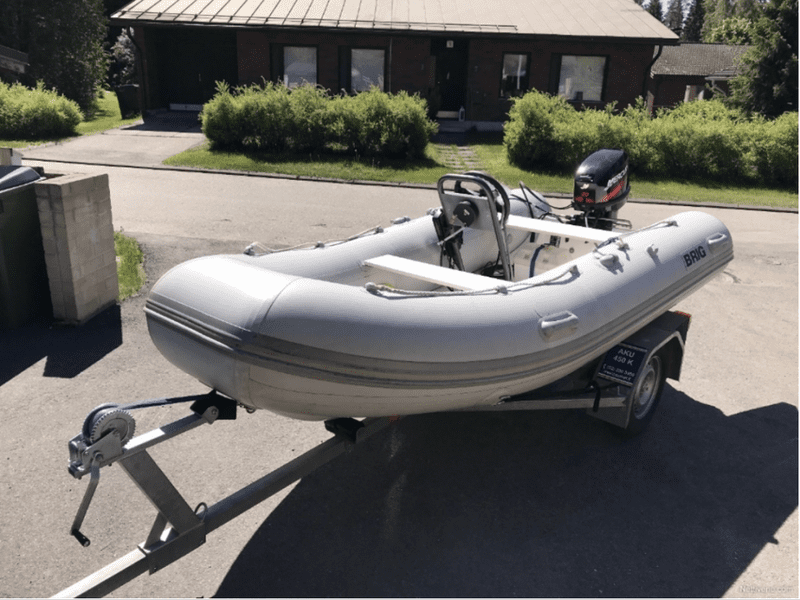
The chambers must be well inflated, the boat must be securely fastened - special trailers have towing units for this, both for RIB and for other types of inflatable motor boats.
RIB after careful washing and drying is stored directly on the trailer. The tender should be stored in a dry room, preferably heated in winter.
If the size of the room and the tender allows, it can be hung from the ceiling in an inflated state.
Before long-term storage, the boat should be thoroughly washed with soap or other neutral detergent, the motor and seats removed, dried well, treated with rodenticides. A completely dry boat can be folded in the order shown in the photo below.
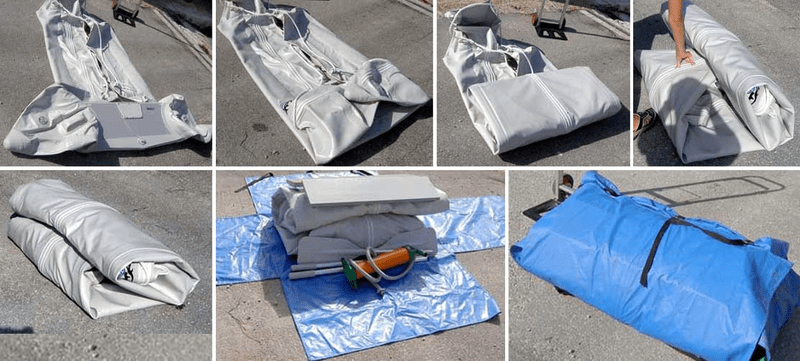
Functionality and Features
Inflatable keels are used to improve the seaworthiness of inflatable boats. They allow you to confidently cut through water flows, facilitate control, increase the maneuverability of the boat.
Many parts of the boat can be replaced or restored in case of loss or failure - oars, seats, all types of bottom floors.
Safety
Depending on the water area in which you are going to use your dinghy, choose its certification appropriately - it must be indicated in the instructions.
The category of the vessel determines the area of operation of the dinghy based on its design:
- Category A - ocean. The boat is designed for ocean crossings when the wind force exceeds 8 points, and the wave height can exceed 4 m.
- Category B - sea. The boat is designed for sea travel when the wind force reaches 8 points, and the wave height reaches 4 m.
- Category C - coastal waters. You can sail in the boat in coastal waters, large bays and bays, rivers and lakes, with a wind strength of about 6 points and a wave height of 2 m.
- Category D - protected waters, or inland waters. The boat can be used in lakes, rivers and canals, where the wind force is not more than 4 points, and the wave height is about 0.5 m.
Safety Tips During Use
In addition to the fact that you must choose a tender certified for the right category, you must also ensure the personal safety of the passengers on board.
We recommend purchasing certified personal watercraft (vests, jackets, sleeves) and make sure that passengers are properly equipped for boarding and disembarking, and that the dinghy is equipped with certified life-saving equipment - a raft, a life buoy, etc.
The tender must be equipped with signaling devices and navigation lights, even if no night crossings are foreseen.
Care and Maintenance
Do not shorten the life of the tender by neglecting timely care and maintenance. In fact, it is not at all difficult, although it takes time, of course. Well, it's your choice what to save on: time is money indeed.
Practical Tips for Care and Maintenance of an Inflatable Boat
- After the sea trip, clean the surface of the boat from fish oil, grains of sand and algae, especially carefully clean the seams.
- Clean all components - pump, oars, engine.
- Do not leave a wet boat in a storage area, so that it does not become covered with mold or ice crust during winter.
- Wash your boat with soap or other neutral detergent, not abrasive powders. Do not use metal washcloths - only soft sponges.
- Carefully fold the boat - store the product folded. Make sure that when folding it, twigs and dirt don’t get in.
- Dry the inflated boat - this way the water will drain better.
- Roll the craft with the valves open from stern to bow. If you have a model with a motor, the ends of the cylinders must be pressed against the transom.
- Store your boat in a safe place - new boats are often infested with rodents. You can protect yourself from uninvited guests by washing the fabric well. Then there will be no smell of fish, which mice like so much.
- Create optimal storage conditions - the room temperature should be maintained between 0 and 25 °C. If you have left the boat in sub-zero temperatures, let it warm up before use.
- Do not use talcum powder on PVC, neopren and hypalon boats - it is only good for rubber.
- Read the instructions carefully and always follow the manufacturer's recommendations.
- At negative temperatures, it is better not to unfold or move a rolled boat, as unwanted cracks may form on the fabric.
Boat Inspection and Repair
Inspect the boat after each ride for early signs of damage. On board, you should have a repair kit for sealing punctures and minor damage - patches, polyurethane glue.
If the boat hull is made of fiberglass, inspect it for osmotic manifestations.
Control the operation of the filling valve so that you do not end up in a boat with deflated chambers during the transition. When inspecting the tender motor, pay attention to the gearbox. If the boat is not used for a long time, remove the resulting condensate in time.
If problems are noticed, the tender should not be used, and the appropriate service center should be contacted to fix them if there is no professional mechanic on the yacht.
Failure to follow the rules of maintenance reduces the life of the boat by 2-3 times.
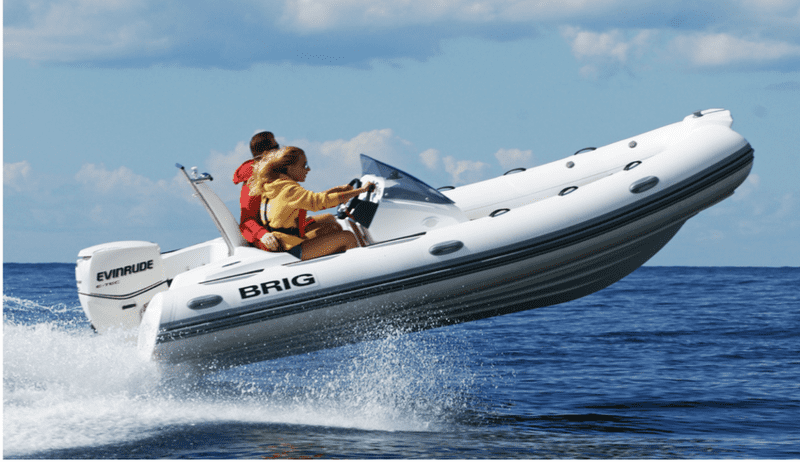
Recommendations from Professionals
In this section, you can read excerpts from the publications of the leading yachting media about the selection of a tender for a yacht with links to these articles.
Conclusion
In this article, we briefly touched on the points that you should consider when choosing an inflatable. dinghy for your yacht, namely:
- types of tender boats depending on their design - motor-rowing, motor with a different type of floor, motor with a rigid hull - RIB;
- materials from which they are made: PVC, neopren and hypalon - for inflatable chambers, aluminum or plywood for slatted floor or solid flooring, fiberglass, carbon fiber and aluminum alloy for the body;
- parameters to be guided by when choosing: the region of navigation, the number of passengers, the load on the tender - in order to correctly calculate the required size of the dinghy and it’s carrying capacity;
- CE certification depending on the water area where you plan to use the boat.
Hopefully, this information was useful to you – we wish you good luck in finding a perfect dinghy for your vessel. In our next article we are going to discuss inflatable and rigid types of dinghies: what they have in common and how they differ, as well as different factors for choosing the right dinghy type based on your requirements – so stay tuned!





